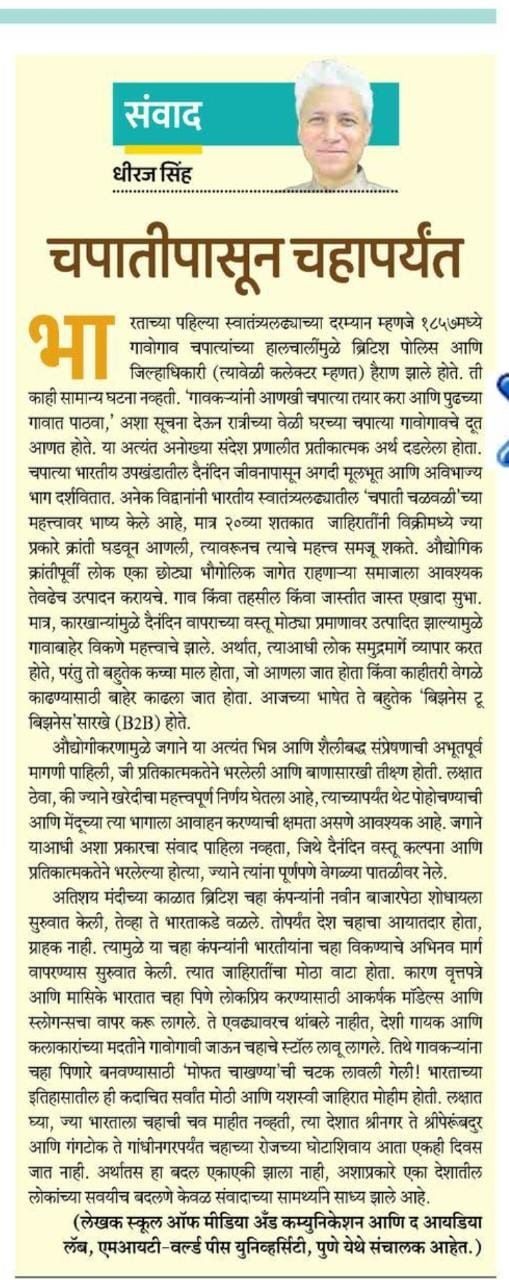From Chapati To Chai (My Column in Sakal Newspaper)
By Dhiraj Singh
In 1857 British policemen and collectors were baffled by the movement of chapatis from village to village. It was no ordinary event. Homemade chapatis were being brought by messengers to villages at night with instructions that villagers prepare more chapatis and send them to the next village. This unique messaging system was filled with symbolic meaning. The chapatis signified something very basic and also something inseparable from the daily life of the Indian subcontinent. It was something that everybody had every single day of their live.
Many scholars have argued over the importance of the ‘Chapati Movement’ in the Indian Freedom struggle but its significance can only be understood in the way advertising revolutionised sales in the 20th century. Before the Industrial Revolution people produced only as much as was needed by a community living in a smallish geographical space—a village or a tehsil or at the most a sooba. But with factories mass producing items of daily use it became important to sell outside the village. Of course people traded through sea before that but it was mostly raw material that was being brought in or taken out to produce something else. In today’s parlance it was mostly B2B.
With industrialization the world saw an unprecedented demand for this highly differentiated and stylised communication that was pregnant with symbolism yet sharp as an arrow. Remember it had to have the ability to reach directly and appeal to the part of the brain that made important purchase decisions. The world had not seen this kind of communication before where everyday items were impregnated with ideas and symbolism that took them to another level altogether.
During the Great Depression when British tea companies began to look for newer markets they turned to India, which up until then was only an importer of tea and not a consumer. So these tea companies began to use novel ways of selling tea to Indians. And advertising had a big hand in it as newspapers and magazines began to use attractive models and slogans to popularise tea drinking in India. They didn’t stop there, they began to hire native singers and performers who went from village to village setting up tea demonstration stalls where villagers were given ‘free tastings’ in order to convert them into tea-drinkers. This was perhaps the largest and most successful advertising campaign launched in the history of India. Transforming India from a country with no taste for tea to a place where not a day passes without a daily dose of chai from Srinagar to Sriperumbudur and from Gangtok to Gandhinagar. And all of it has been achieved by the power of communication.
Dhiraj Singh is a well-known journalist, author, artist and TV personality whose latest novel ‘MASTER O’ is a sci-fi political thriller. He is currently Director, School of Media & Communication & The Idea Lab, MIT-World Peace University, Pune
In 1857 British policemen and collectors were baffled by the movement of chapatis from village to village. It was no ordinary event. Homemade chapatis were being brought by messengers to villages at night with instructions that villagers prepare more chapatis and send them to the next village. This unique messaging system was filled with symbolic meaning. The chapatis signified something very basic and also something inseparable from the daily life of the Indian subcontinent. It was something that everybody had every single day of their live.
Many scholars have argued over the importance of the ‘Chapati Movement’ in the Indian Freedom struggle but its significance can only be understood in the way advertising revolutionised sales in the 20th century. Before the Industrial Revolution people produced only as much as was needed by a community living in a smallish geographical space—a village or a tehsil or at the most a sooba. But with factories mass producing items of daily use it became important to sell outside the village. Of course people traded through sea before that but it was mostly raw material that was being brought in or taken out to produce something else. In today’s parlance it was mostly B2B.
With industrialization the world saw an unprecedented demand for this highly differentiated and stylised communication that was pregnant with symbolism yet sharp as an arrow. Remember it had to have the ability to reach directly and appeal to the part of the brain that made important purchase decisions. The world had not seen this kind of communication before where everyday items were impregnated with ideas and symbolism that took them to another level altogether.
During the Great Depression when British tea companies began to look for newer markets they turned to India, which up until then was only an importer of tea and not a consumer. So these tea companies began to use novel ways of selling tea to Indians. And advertising had a big hand in it as newspapers and magazines began to use attractive models and slogans to popularise tea drinking in India. They didn’t stop there, they began to hire native singers and performers who went from village to village setting up tea demonstration stalls where villagers were given ‘free tastings’ in order to convert them into tea-drinkers. This was perhaps the largest and most successful advertising campaign launched in the history of India. Transforming India from a country with no taste for tea to a place where not a day passes without a daily dose of chai from Srinagar to Sriperumbudur and from Gangtok to Gandhinagar. And all of it has been achieved by the power of communication.
Dhiraj Singh is a well-known journalist, author, artist and TV personality whose latest novel ‘MASTER O’ is a sci-fi political thriller. He is currently Director, School of Media & Communication & The Idea Lab, MIT-World Peace University, Pune



Comments
Post a Comment